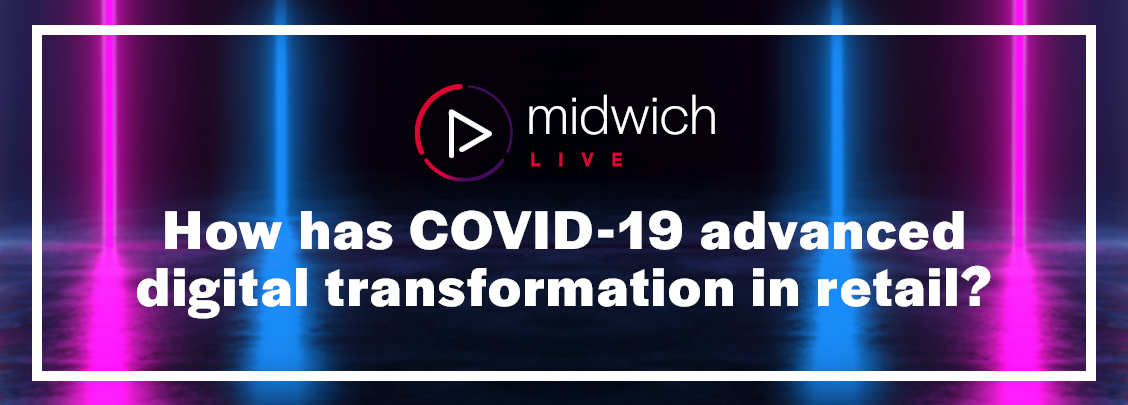How has COVID-19 advanced digital transformation in retail?
COVID-19 has undeniably accelerated technology and transformed the way we shop. Physical shops were already on the decline, hailed as ‘the death of the high street’ and that only worsened when the government announced multiple lockdowns.
But as shops began to reopen, the retail industry was forced into a digital transformation, including small local shops. Digital signage has played a huge role in this transition and continues to.
On the second episode of Midwich Live, our hosts, Jenny Hicks, Head of Technology at Midwich Group and Chris Neto, AV professional, were joined by Paul Crosbie-Smith from BrightSign to discuss the recent and future developments in retail technology.
How did COVID-19 impact the retail industry at the beginning?
What we found at the very beginning was that digital signage was not being leveraged as successfully as it could have been. Fashion and product advertisements were the main focus of digital signage displays. Surprisingly, existing digital signage in retail was often not being utilised for wayfinding or health and well-being information. Rather, this was communicated through paper posters or floor stickers.
Similarly, employees were hired to manage queues but as Jenny Hicks said, “human beings get distracted, digital signage does not”.
The retail industry was hit hard and budgets were likely restricted, but it’s clear that the aftermath of COVID-19 will last a long time. As these transformations are here to stay, the retail industry has had to adapt. And like Paul Crosbie-Smith from BrightSign says,
“During a crisis situation, things accelerate, and they accelerate at such a speed that people catch up very very quickly”.
The retail industry was quick to adapt
The retail industry was able to adapt so quickly because the technology already existed. Mobile phones have become more necessary now than ever, enabling us to partake in normal activities.
Take the QR code, for example, mobile phones have had the capacity for years and now, it has become a staple part of our everyday life - from checking in using the NHS Track and Trace app, to picking up the food shopping, to viewing the menu at a restaurant. QR codes have been so successful because they’re simple to use and easy to understand universally.
"Literally overnight, QR codes became our best friend"
- Paul Crosbie-Smith
We've seen the QR code particularly present in restaurants, replacing traditional menus with contactless digital menus. Even as restaurants increase their capacity, it's likely that digital menus will remain the 'new normal' to not only guarantee safety for employees and customers. But it also gives restaurants more power to change the appearance of the menu, edit the content and reduce waste and printing costs - all in real-time.
Where once visual experience was a big part of digital signage, technology that can combat challenges and improve efficiency is a priority. Digital signage for wayfinding and managing queues is an easy solution that provides instant information. It helps customers navigate stores quicker and eliminates the need for extra staff managing this system.
Future developments in interactive technology for retail
Touch screen is often thought of as the only way for consumers to drive interactive experiences, but in recent years gesture and motion sensors have been introduced too. As COVID-19 has temporarily removed touch as an option, technology in retail has adapted and accelerated.
Voice-activated technology is likely to become predominant in the future of retail. Almost any digital signage display could be voice. BrightSign are key innovators of digital signage and their BrightVoice is a voice-activated solution that delivers a unique hands-free interactive experience. It is able to control shopping experience and deliver tailor-made conversation and engagement with consumers.
Similarly, BrightLink takes the QR code even further by allowing users to view and control a touch screen display on their mobile phone after a quick scan – removing any fear of touch. It is believed that touchscreen will return so innovative features like the QR code and BrightLink prevent those applications from becoming redundant.
Other sensor and facial recognition systems that don't require touching include thermometer displays and entrance control.
The digital transformation accelerated by COVID-19 has also given physical and online stores a better chance to deliver a coordinated message. Using the same advertisements and content is more consistent.
When it comes to digital signage displays in store, it will offer consumers an engaging digital experience, giving them access to real-time information on products, wayfinding and the latest health and safety guidelines.
Midwich Live is aired on the last Friday of every month and is streamed on YouTube, LinkedIn, Facebook, Twitch, Twitter and Periscope. To get involved and join the community, search for Midwich Live.

 Midwich Limited, Vinces Road, Diss, Norfolk, IP22 4YT
Midwich Limited, Vinces Road, Diss, Norfolk, IP22 4YT